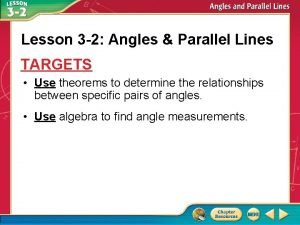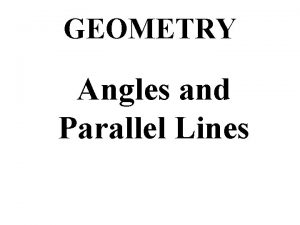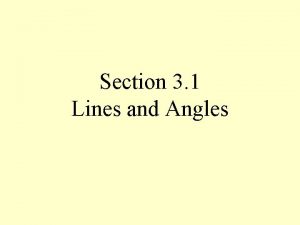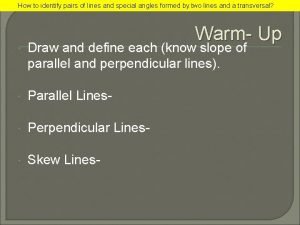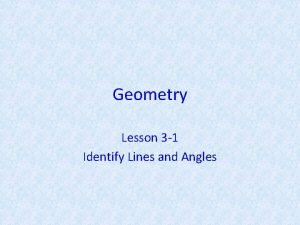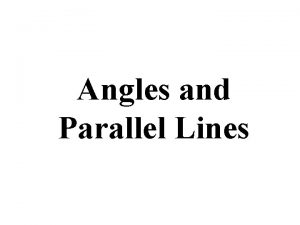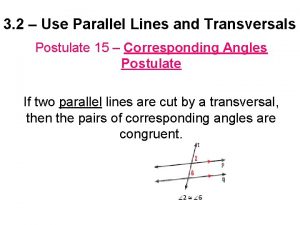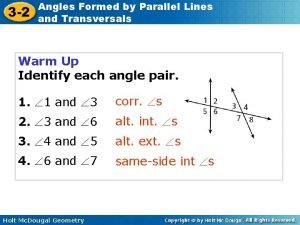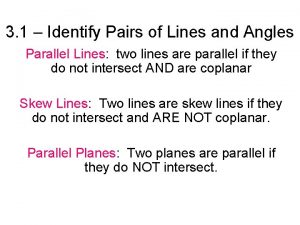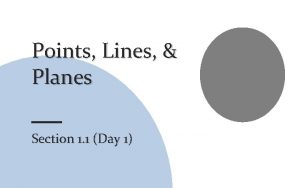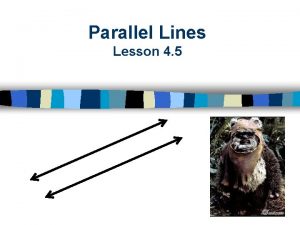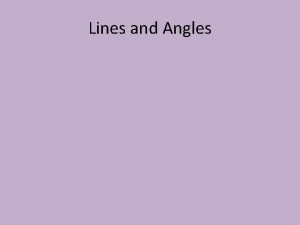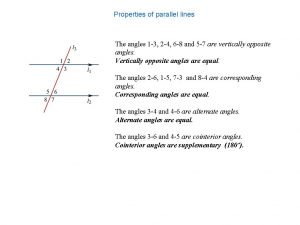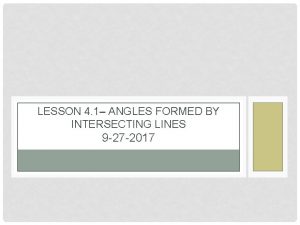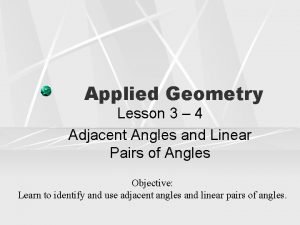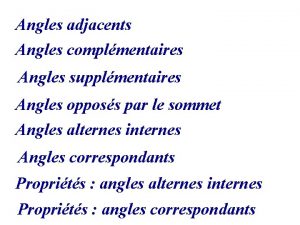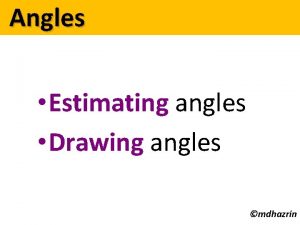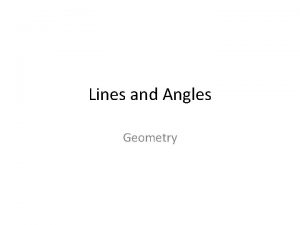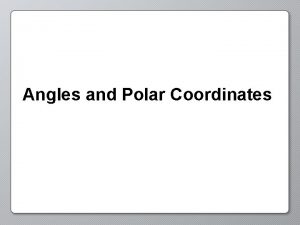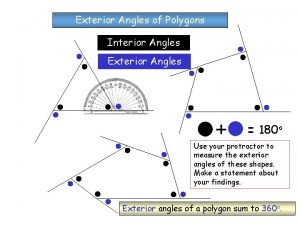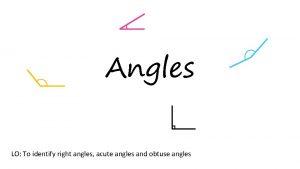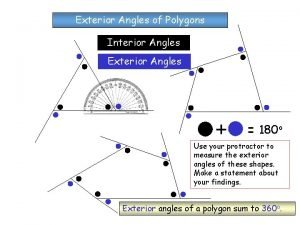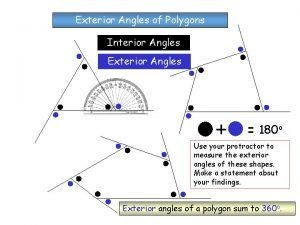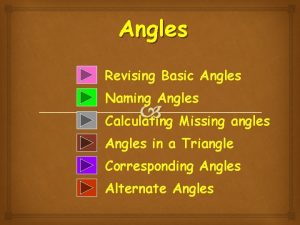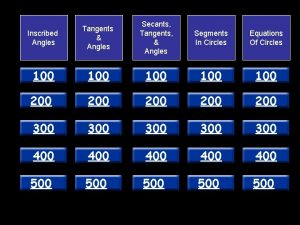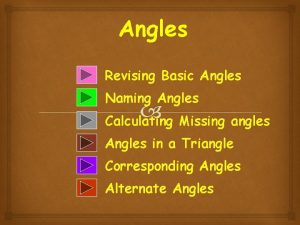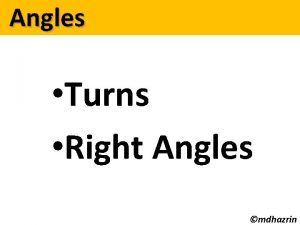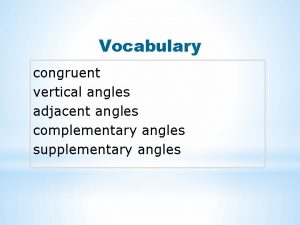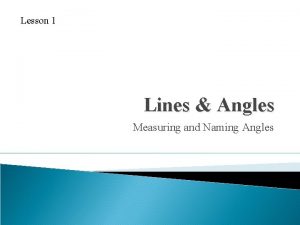Contents S 1 Lines and angles S 1






























- Slides: 30

Contents S 1 Lines and angles S 1. 1 Labelling lines and angles S 1. 2 Parallel and perpendicular lines S 1. 3 Calculating angles S 1. 4 Angles in polygons 1 of 69 © Boardworks Ltd 2004

Angles in a triangle 2 of 69 © Boardworks Ltd 2004

Angles in a triangle c a b For any triangle, a + b + c = 180° The angles in a triangle add up to 180°. 3 of 69 © Boardworks Ltd 2004

Angles in a triangle We can prove that the sum of the angles in a triangle is 180° by drawing a line parallel to one of the sides through the opposite vertex. a a b c b These angles are equal because they are alternate angles. Call this angle c. a + b + c = 180° because they lie on a straight line. The angles a, b and c in the triangle also add up to 180°. 4 of 69 © Boardworks Ltd 2004

Calculating angles in a triangle Calculate the size of the missing angles in each of the following triangles. 116° a 33° 31° b 64° 49° 43° d 25° c 88° 233° 5 of 69 326° 82° 28° © Boardworks Ltd 2004

Angles in an isosceles triangle In an isosceles triangle, two of the sides are equal. We indicate the equal sides by drawing dashes on them. The two angles at the bottom on the equal sides are called base angles. The two base angles are also equal. If we are told one angle in an isosceles triangle we can work out the other two. 6 of 69 © Boardworks Ltd 2004

Angles in an isosceles triangle For example, 88° a 46° Find the size of the other two angles. The two unknown angles are equal so call them both a. We can use the fact that the angles in a triangle add up to 180° to write an equation. 88° + a = 180° 88° + 2 a = 180° 2 a = 92° a = 46° 7 of 69 © Boardworks Ltd 2004

Polygons A polygon is a 2 -D shape made when line segments enclose a region. A The line segments are called sides. B C E The end points are called vertices. One of these is called a vertex. D 2 -D stands for two-dimensional. These two dimensions are length and width. A polygon has no height. 8 of 69 © Boardworks Ltd 2004

Naming polygons Polygons are named according to the number of sides they have. Number of sides Name of polygon Triangle 3 Quadrilateral 4 9 of 69 5 Pentagon 6 7 8 9 10 Hexagon Heptagon Octagon Nonagon Decagon © Boardworks Ltd 2004

Interior angles in polygons The angles inside a polygon are called interior angles. b c a The sum of the interior angles of a triangle is 180°. 10 of 69 © Boardworks Ltd 2004

Exterior angles in polygons When we extend the sides of a polygon outside the shape exterior angles are formed. e d f 11 of 69 © Boardworks Ltd 2004

Interior and exterior angles in a triangle Any exterior angle in a triangle is equal to the sum of the two opposite interior angles. c ca b b a=b+c We can prove this by constructing a line parallel to this side. These alternate angles are equal. These corresponding angles are equal. 12 of 69 © Boardworks Ltd 2004

Interior and exterior angles in a triangle 13 of 69 © Boardworks Ltd 2004

Calculating angles Calculate the size of the lettered angles in each of the following triangles. b 116° a 33° 64° 82° 31° 34° c 43° d 25° 131° 152° 127° 272° 14 of 69 © Boardworks Ltd 2004

Calculating angles Calculate the size of the lettered angles in this diagram. 56° a 86° 38º 104° b 69° 73° Base angles in the isosceles triangle = (180º – 104º) ÷ 2 = 76º ÷ 2 = 38º Angle a = 180º – 56º – 38º = 86º Angle b = 180º – 73º – 38º = 69º 15 of 69 © Boardworks Ltd 2004

Sum of the interior angles in a quadrilateral What is the sum of the interior angles in a quadrilateral? c d a f b e We can work this out by dividing the quadrilateral into two triangles. a + b + c = 180° So, and d + e + f = 180° (a + b + c) + (d + e + f ) = 360° The sum of the interior angles in a quadrilateral is 360°. 16 of 69 © Boardworks Ltd 2004

Sum of interior angles in a polygon We already know that the sum of the interior angles in any triangle is 180°. a + b + c = 180 ° a b d c c a b We have just shown that the sum of the interior angles in any quadrilateral is 360°. a + b + c + d = 360 ° Do you know the sum of the interior angles for any other polygons? 17 of 69 © Boardworks Ltd 2004

Sum of the interior angles in a pentagon What is the sum of the interior angles in a pentagon? c d a f b e h g i We can work this out by using lines from one vertex to divide the pentagon into three triangles. a + b + c = 180° and d + e + f = 180° and g + h + i = 180° So, (a + b + c) + (d + e + f ) + (g + h + i) = 540° The sum of the interior angles in a pentagon is 540°. 18 of 69 © Boardworks Ltd 2004

Sum of the interior angles in a polygon We’ve seen that a quadrilateral can be divided into two triangles … … and a pentagon can be divided into three triangles. many triangles can a AHow hexagon can be divided hexagon be divided into? into four triangles. 19 of 69 © Boardworks Ltd 2004

Sum of the interior angles in a polygon The number of triangles that a polygon can be divided into is always two less than the number of sides. We can say that: A polygon with n sides can be divided into (n – 2) triangles. The sum of the interior angles in a triangle is 180°. So, The sum of the interior angles in an n-sided polygon is (n – 2) × 180°. 20 of 69 © Boardworks Ltd 2004

Interior angles in regular polygons A regular polygon has equal sides and equal angles. We can work out the size of the interior angles in a regular polygon as follows: Name of regular polygon Sum of the interior angles Size of each interior angle Equilateral triangle 180° ÷ 3 = 60° Square 2 × 180° = 360° ÷ 4 = 90° Regular pentagon 3 × 180° = 540° ÷ 5 = 108° Regular hexagon 4 × 180° = 720° ÷ 6 = 120° 21 of 69 © Boardworks Ltd 2004

Interior and exterior angles in an equilateral triangle In an equilateral triangle, Every interior angle measures 60°. 120° 60° 60° 120° 22 of 69 Every exterior angle measures 120°. The sum of the interior angles is 3 × 60° = 180°. The sum of the exterior angles is 3 × 120° = 360°. © Boardworks Ltd 2004

Interior and exterior angles in a square In a square, Every interior angle measures 90° 90° 23 of 69 90° Every exterior angle measures 90°. The sum of the interior angles is 4 × 90° = 360°. The sum of the exterior angles is 4 × 90° = 360°. © Boardworks Ltd 2004

Interior and exterior angles in a regular pentagon In a regular pentagon, Every interior angle measures 108°. 72° 108° Every exterior angle measures 72°. 108° 72° 24 of 69 The sum of the interior angles is 5 × 108° = 540°. The sum of the exterior angles is 5 × 72° = 360°. © Boardworks Ltd 2004

Interior and exterior angles in a regular hexagon In a regular hexagon, Every interior angle measures 120°. 60° 120° 120° 60° 25 of 69 60° Every exterior angle measures 60°. The sum of the interior angles is 6 × 120° = 720°. The sum of the exterior angles is 6 × 60° = 360°. © Boardworks Ltd 2004

The sum of exterior angles in a polygon For any polygon, the sum of the interior and exterior angles at each vertex is 180°. For n vertices, the sum of n interior and n exterior angles is n × 180° or 180 n°. The sum of the interior angles is (n – 2) × 180°. We can write this algebraically as 180(n – 2)° = 180 n° – 360°. 26 of 69 © Boardworks Ltd 2004

The sum of exterior angles in a polygon If the sum of both the interior and the exterior angles is 180 n° and the sum of the interior angles is 180 n° – 360°, the sum of the exterior angles is the difference between these two. The sum of the exterior angles = 180 n° – (180 n° – 360°) = 180 n° – 180 n° + 360° = 360° The sum of the exterior angles in a polygon is 360°. 27 of 69 © Boardworks Ltd 2004

Take Turtle for a walk 28 of 69 © Boardworks Ltd 2004

Find the number of sides 29 of 69 © Boardworks Ltd 2004

Calculate the missing angles This pattern has been made with three different shaped tiles. The length of each side is the same. 50º What shape are the tiles? Calculate the sizes of each angle in the pattern and use this to show that the red tiles must be squares. = 50º 30 of 69 = 40º = 130º = 140º = 150º © Boardworks Ltd 2004
 Vertical
Vertical Two nonadjacent angles formed by two intersecting lines
Two nonadjacent angles formed by two intersecting lines Module 15 angles and segments in circles answer key
Module 15 angles and segments in circles answer key Black's classification of cavities
Black's classification of cavities 3-2 properties of parallel lines
3-2 properties of parallel lines Lesson 3-7 parallel lines and transversals
Lesson 3-7 parallel lines and transversals 3-2 angles and parallel lines
3-2 angles and parallel lines Geometry
Geometry Intersecting lines angles
Intersecting lines angles 3-1 lines and angles
3-1 lines and angles Identify pairs of lines and angles worksheet
Identify pairs of lines and angles worksheet 3-1 lines and angles
3-1 lines and angles Angles with parallel and intersecting lines
Angles with parallel and intersecting lines 3-1 lines and angles
3-1 lines and angles Angles & lines unit warm ups
Angles & lines unit warm ups Transversal postulate
Transversal postulate 3-2 angles formed by parallel lines and transversals
3-2 angles formed by parallel lines and transversals 3-1 lines and angles
3-1 lines and angles Angles on a straight line worksheet with answers
Angles on a straight line worksheet with answers Adjacent angles
Adjacent angles Lesson 8: solve for unknown angles—angles in a triangle
Lesson 8: solve for unknown angles—angles in a triangle Naming points lines and planes
Naming points lines and planes Lines are lines that never touch and are coplanar.
Lines are lines that never touch and are coplanar. Break line engineering
Break line engineering Def of parallel lines
Def of parallel lines Two nonadjacent angles formed by two intersecting lines
Two nonadjacent angles formed by two intersecting lines Angle properties of parallel lines
Angle properties of parallel lines Angles formed by parallel lines cut by a transversal
Angles formed by parallel lines cut by a transversal Transversal vocabulary
Transversal vocabulary Congruent angles formed by intersecting lines
Congruent angles formed by intersecting lines Linear pair example
Linear pair example






